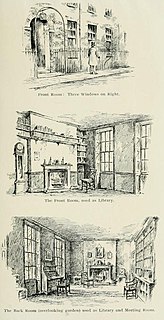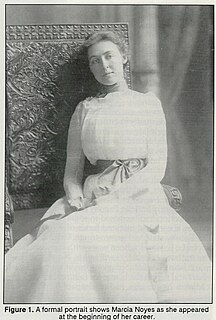Related Research Articles

Sir William Osler, 1st Baronet, was a Canadian physician and one of the four founding professors of Johns Hopkins Hospital. Osler created the first residency program for specialty training of physicians, and he was the first to bring medical students out of the lecture hall for bedside clinical training. He has frequently been described as the Father of Modern Medicine and one of the "greatest diagnosticians ever to wield a stethoscope". Osler was a person of many interests, who in addition to being a physician, was a bibliophile, historian, author, and renowned practical joker. One of his achievements was the founding of the History of Medicine Society, at the Royal Society of Medicine, London.

The Johns Hopkins Hospital (JHH) is the teaching hospital and biomedical research facility of the Johns Hopkins School of Medicine, located in Baltimore, Maryland, U.S. It was founded in 1889 using money from a bequest of over $7 million by city merchant, banker/financier, civic leader and philanthropist Johns Hopkins (1795–1873). Johns Hopkins Hospital and its school of medicine are considered to be the founding institutions of modern American medicine and the birthplace of numerous famous medical traditions including rounds, residents and house staff. Many medical specialties were formed at the hospital including neurosurgery, by Harvey Cushing and Walter Dandy; cardiac surgery by Alfred Blalock; and child psychiatry, by Leo Kanner. Attached to the hospital is the Johns Hopkins Children’s Center which serves infants, children, teens, and young adults aged 0–21.

The Medical and Chirurgical Society of London was a learned society of physicians and surgeons which was founded in 1805 by 26 personalities in these fields who had left the Medical Society of London because of disagreement with the autocratic style of its president, James Sims. Among its founders there were William Saunders (1743–1817), its first president; John Yelloly (1774–1842), Sir Astley Cooper (1768–1841), the first treasurer; Alexander Marcet (1770–1822) and Peter Mark Roget (1779–1869).
The University of Maryland School of Medicine, located in Baltimore City, Maryland, U.S., is the medical school of the University of Maryland, Baltimore and is affiliated with the University of Maryland Medical Center and Medical System. Established in 1807 as the College of Medicine of Maryland, it is the first public and the fifth oldest medical school in the United States. It was also the first medical school to institute a residency training program. UMB SOM's campus includes Davidge Hall, which was built in 1812, and is the oldest building in continuous use for medical education in the Northern Hemisphere.
Tyler C. Cymet, D.O., FACP, FACOFP, FACHT is a physician in Baltimore, Maryland. Cymet attended Emory University for his premedical undergraduate degree and majored in psychology and anthropology. He then attended medical school at Nova Southeastern University College of Osteopathic Medicine to acquire his medical degree, served as an intern at the Midwestern University Graduate Medical Education system, performed a Primary Care Internal Medicine residency at Yale University, and did additional training at Sinai Hospital of Baltimore.

William Henry Welch was an American physician, pathologist, bacteriologist, and medical school administrator. He was one of the "Big Four" founding professors at the Johns Hopkins Hospital. He was the first dean of the Johns Hopkins School of Medicine and was also the founder of the Johns Hopkins School of Hygiene and Public Health, the first school of public health in the country. Welch was more known for his cogent summations of current scientific work, than his own scientific research. The Johns Hopkins medical school library is also named after Welch. In his lifetime, he was called the "Dean of American Medicine" and received various awards and honors throughout his lifetime, and posthumously.

Dan K. Morhaim, an American politician and physician, is a member of the Maryland House of Delegates representing northwest Baltimore County. He has been a leader in legislation concerning healthcare, the environment, and streamlining government operations. He is also the author of the book The Better End (2011), endorsed by Maya Angelou, and he has written numerous articles for medical publications and the general media. His new book "Preparing for a Better End" is available Nov 2020 and received excellent review and endorsements from a diverse group of distinguished people.

Christopher Christian Cox was known as an American surgeon, professor at Philadelphia College of Medicine and served briefly as a politician.

William Beanes was an American physician who became indirectly responsible for the writing of the national anthem of the United States. Beanes was a Maryland resident, and upon the British invasion of Maryland during the War of 1812 offered British commanders the use of his home. However, Beanes arrested British deserters who had taken to ransacking local farms in search of food, an act which led to his arrest and detention by the British.

Richard Sprigg Steuart (1797–1876) was a Maryland physician and an early pioneer of the treatment of mental illness. In 1838 he inherited four contiguous farms, totalling approximately 1900 acres as well as 150 slaves.
Washington University was a medical school in Baltimore, Maryland. It was founded in 1827, chartered as Washington Medical College in 1833, closed in 1851, revived in 1867 as Washington University, and closing for good in 1878. The remains were absorbed into the College of Physicians and Surgeons, later the University of Maryland School of Medicine.
William Rush Dunton Jr was a founder and early president of the American Occupational Therapy Association. He is also recognized for his collection of, and scholarship about, American quilts.

Torrey C. Brown was an American politician who served in the Maryland House of Delegates and was the Secretary of the Maryland Department of Natural Resources.

Marcia Crocker Noyes was the librarian at The Maryland State Medical Society from 1896 to 1946, and was a founding and presiding member of the Medical Library Association.
If I have accomplished anything, let that speak for me, as while making a living, I tried to make a life.
Mary Sherwood was a physician, educator, and spokesperson for preventive medicine, public health, women's health, childcare. She played a vital role in many women's organizations and clubs, as well as contributed to many medical social movements in Maryland and Baltimore.

John Crawford, an introducer of vaccination into America and investigator into the cause of disease, was born in the north of Ireland May 3, 1746. He was the second of four sons of a Protestant clergyman, all of whom became professional men, his brother Adair being physician to St. Thomas' Hospital, London, and professor of chemistry at Woolwich. At seventeen he entered Trinity College Dublin, and afterwards went to the Leyden University, where he graduated M. D. He then made two voyages to the East Indies as surgeon in the East India Company's service. About 1778 he was married and shortly after received an appointment as surgeon to the Naval Hospital on the Island of Barbadoes, a position of great responsibility. In 1780 a terrible hurricane devastated the island, where upon he furnished aid and medicines to the afflicted inhabitants without stint and without compensation. In 1781 he returned to England on account of bad health and during the voyage lost his wife. In 1790 he received from the Dutch government the appointment of surgeon-major to the colony of Demerara in South America; there he had charge of a military hospital of sixty to eighty beds.
Whitfield Winsey, was the first African American doctor admitted to the Medical and Chirurgical Faculty of Maryland. Winsey was born to William H. and Malvina Gibbs Winsey of Baltimore. The Winseys were a free African American family and William Winsey earned enough money as a brickmaker to provide a private education for his son, Whitfield.
Donald Stuart Gann was an American trauma surgeon. He chaired surgical departments at Case Western Reserve University, Brown University, Johns Hopkins School of Medicine, and the University of Maryland School of Medicine. He was a past president of the Biomedical Engineering Society and the American Association for the Surgery of Trauma.

Amanda E. Taylor Norris was an American physician, the first woman physician in the state of Maryland. After graduating from the Woman's Medical College of Pennsylvania in 1880, she worked in private practice in the Baltimore area, spending nearly two decades teaching at coeducational and women's medical schools there.

Emily Hammond Wilson Walker was an American doctor. Only the second woman to graduate from her medical school, the Medical College of Georgia, she was initially refused a position at Anne Arundel Hospital but went on to become its chief of staff. A career country doctor of more than 50 years, she set up early sexual health and prenatal clinics, and diagnosed the first case of Rocky Mountain spotted fever in Maryland. She was known for her willingness to treat all patients regardless of means as well as her resistance to Jim Crow segregation, welcoming African American patients into her waiting room alongside white ones.